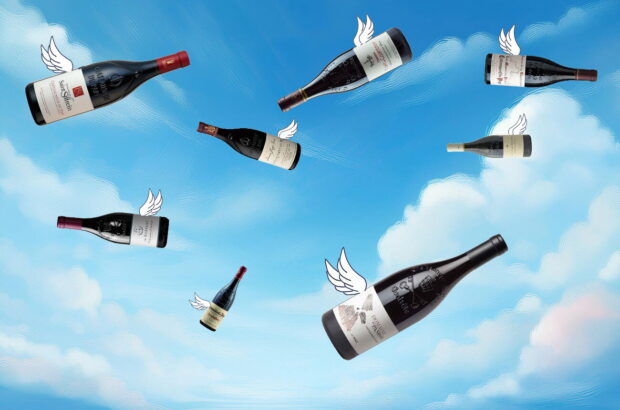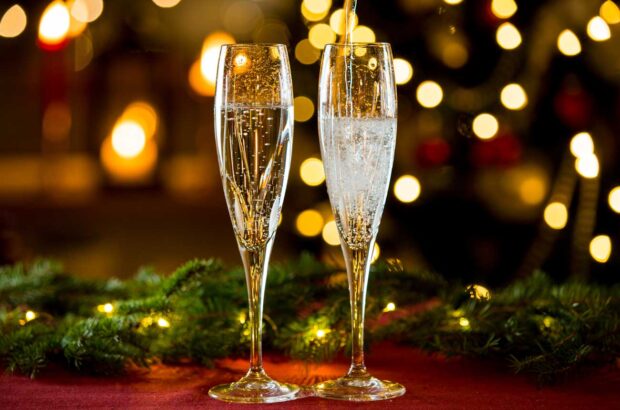British restaurant wine lists are famous for their hugely marked-up prices, and most are unapologetic. JAMES AUFENAST finds out why, and looks at which offer the best value.
A bottle of the 2004 vintage of Boekenhoutskloof’s Chocolate Block costs £14.99 at Oddbins on London’s Curzon Street. A couple of streets north, The Greenhouse restaurant is selling the same rich, plummy South African Shiraz for £65. Five minutes separate the two places via elegant Mayfair streets, but it’s still the same wine, multiplied in price by four. Many people may be enticed by the gastronomic-themed name, but why are they paying so much more for it on restaurant wine lists?
It doesn’t seem the world’s best deal, especially when you consider that the sommelier would have bought the wine for about £10, meaning the price has actually been hiked by 550%. But Marlon Abela, owner of The Greenhouse is adamant that his prices are fair. ‘We’re generally reasonable in what we charge. This wine is an exception, it’s probably an oversight; we only mark up what we need to in order to run a business.’
https://www.decanter.com/wine-news/millionaire-restaurant-owner-acquires-wine-merchant-ow-loeb-4115/
Running a restaurant business seems to be done at wine lovers’ expense, however. Abela’s much-lauded restaurant is no different from many others. At Pied à Terre in nearby Soho, John Duval’s 2004 Plexus is £55, compared with £15 at the Wine Supply Company. Wynns Coonawarra, John Riddoch 1996 from Australia is £100 at Park Lane’s Nobu, compared with £30.29 at Everywine. And it’s not just a problem peculiar to central London. At Le Manoir aux Quat’ Saisons, in the Oxfordshire countryside, Domaine des Comtes Lafon’s 1999 Meursault is £220, over four times the retail price at Farr Vintners.
In fact, the remarkable thing about Decanter’s survey of restaurant wine lists is the uniformity of mark-ups in top restaurants. Wines are mostly increased by three to four times the retail price level in nearly every Michelin one-, two- and three-star restaurant. The fact that everyone raises their prices by this much doesn’t excuse it, however – in some industries, it would be called price-fixing.
According to Le Manoir owner Raymond Blanc, you can’t compare the retail price with that on restaurant wine lists, since the storage conditions of a supplier are very different from his restaurant. ‘They’ll have a warehouse of concrete, steel and glass against what I own at Le Manoir – expensive art work, an enormous garden to maintain, fine chairs and tables. Every year £2,500 is spent on replacing the Spiegelau glassware and over one third of the £10-million-a-year turnover at Le Manoir comes from staff costs.’
https://www.decanter.com/wine-news/raymond-blanc-wins-aa-lifetime-achievement-award-64903/
OK, so it costs a lot of money to run a top restaurant, but why load so much of it onto wine mark-ups? Blanc has nine sommeliers, but he also employs 40 people in the kitchen to make his Michelin two-star graded food, which seems fairly priced by comparison. Martin Lam, owner of Ransome’s Dock restaurant in Battersea, believes, ‘most people don’t have a clue what a wine costs, and operators take advantage of that fact.’ Top restaurants mark up food on average by a factor of between five and six in terms of the raw materials. But, as Lam says: ‘A meal at The Fat Duck requires an awful lot of skill, thought and effort to put together, and you pay about £100. A bottle at the same price from their wine list may be cracking, but the restaurant hasn’t done a great deal with it, apart from keeping it in the cellar.’ In other words, with Michelin-starred chefs adding value in the kitchen, there’s a strong argument for restaurants charging more for the food, and cutting back on wine mark-ups.
Bring a bottle
You can tell that wine functions as a profit-giver for any restaurant by the fact that so few allow people to bring their own. Even Matt Skinner, the laid-back sommelier from the country of BYO, Australia, refuses to allow customers to carry in bottles at Fifteen. ‘We wouldn’t survive here if we relied on corkage,’ although ‘if someone had a bottle of Mouton-Rothschild and it was a special occasion, I’d make an exception,’ says Skinner – in that case he’d charge £20 a bottle. Marlon Abela, however, refuses corkage in any instance – ‘we have a good enough list here that people don’t need to bring in wines.’ Of course BYO isn’t so important as long as mark-ups are reasonable. According to Skinner, ‘in Australia we do things sensibly, on restaurant wine lists wine is increased by about 150%. You guys go way over the top’.
Most restaurateurs will say they have to keep wine mark-ups high to survive, but Lam believes ‘it’s all down to how people devise their business model, and whether wine is noted down as the giver of all profits.’ Top London restaurants could take a leaf out of Michelin three-star establishments in Paris such as l’Arpège, Guy Savoy or Ducasse at the Plaza Athénée, where food is frequently charged at over £200 per diner, and the wine costs less than it would in the UK. British chef Tom Aikens, who part-owns and cooks at his restaurant of the same name in Chelsea, is convinced things won’t change, however. ‘We’re obsessed with price when it comes to food.’
Even if mark-ups are not a business necessity, they remain a cultural quirk that we are stuck with. How then, to make the best of them, in terms of sniffing out the rare good-value bin from within a list? First things first – best not to start at the beginning. A wine might be priced at £11 in a restaurant, but it can be ‘dishwater or battery acid quality,’ says Lam. It will have cost 50p to make before VAT and duty is added, and the restaurant will make huge profits in terms of percentage. Further down the list, most sommeliers will tell you that at a certain point, a sum of money, rather than percentage increase, is added on to the price of a bottle. When dealing with higher-end wines, this is obviously preferable to having wholesale costs multiplied by three or four. The Vineyard at Stockcross barely increases, in percentage terms, the price of a 1996 Screaming Eagle Cabernet Sauvignon. At £1,425 it’s just 4% higher than the current retail price. The buyer at the restaurant will have probably bought it for under £1,000 originally, so they’re making £500 of profit and the customer is paying a relatively small additional amount to drink it with a good meal in exquisite surroundings, compared with what a merchant sells it for – everyone is happy.
It isn’t always like this, though. Our survey found that although there are examples of good value above £100, many wines in the higher price bracket contain the same increase as those lower down the list. 1985 Sassicaia is £2,500 at Nobu, over three times the price at Fine & Rare, the London-based supplier. So how does a person make sense of all this? Skinner reckons: ‘The best way to get value out of a wine list is to use the sommelier,’ when in fact many people think this would be precisely the worst way to find a reasonably priced wine. However, Skinner points out that people will discover something they wouldn’t have otherwise noticed if they were left to their own devices. ‘I’ve been recommending Verdejo from Telmo Rodriguez, 2005 Basa Blanco [£22 in the restaurant; £4.71 from Andrew Chapman Fine Wines] to customers recently. It smells like Sauvignon Blanc and tastes like Riesling. Plus it’s a lot cheaper than New Zealand whites – perfect.’
It pays to look around the list because on most compilations the big names cost more. Kate Thal used to ramp up the price for Sancerre, Chablis, Rioja and Pouilly-Fuissé when she worked as a sommelier for Conran, ‘because these wines sold themselves, and I wanted to encourage customers to try something different. Many hotels lazily increase everything by the same amount but that means you just end up with a boring list as people buy the same old things.’
At least wine isn’t as highly marked up as coffee, hiked by 1,000% in many a chain. True enough, some of that covers the making of the coffee on the premises – you won’t find many fermentation vats in a restaurant. But as the result is often a thin, milky latte, the skill required to convert raw material into finished product is hardly comparable to a chef in a Michelin-starred kitchen. That’s little comfort, however, to those diners forced by sizeable mark-ups on restaurant wine lists to drink well below the level at which they eat.
The Good
1 Harlan Estate Proprietary Red 1997, £175 at The Ivy (£475 at Fine & Rare) x 0.37
2 Corton-Charlemagne, Coche-Dury, £483 at Sketch (£675 at College Cellar) x0.72
3 Screaming Eagle Cabernet Sauvignon 1996, £1,425 at The Vineyard at Stockcross
(£1,177 at Fine & Rare) x1.2
4 Domaine des Comtes Lafon Le
Montrachet 1999, £900 at Le Gavroche (£773 at Fine & Rare) x1.2
5 Hermitage Cuvée Cathelin, Domaine
Jean-Louis Chave 1985, £985 at Pétrus (£566 at Fine & Rare) x1.75
The bad
1.Pétrus 1928, £11,600 at Petrus (£1,395 at Bordeaux Index) x8.3
2 VDP de l’Herault, Mas de Daumas Gassac 2004, £64 at Waterside Inn (£9.70 at everywine.co.uk for case 12) x6.6
3.Jim Barry ‘The McCrae Wood’ Shiraz, Clare Valley, South Australia 2000, £110 at Zuma (£19.50 at Crq) x5.6
4.Paul Jaboulet Ainé Hermitage La Chapelle 1999, £140 at The Square (£26.70 at Bordeaux Vintners, based on case of 12) x5.24
5 Henri Bourgeois, the MD Loire 2004, £40 at Cinnamon Club (£7.92 at Farr) x5.12
Written by JAMES AUFENAST







